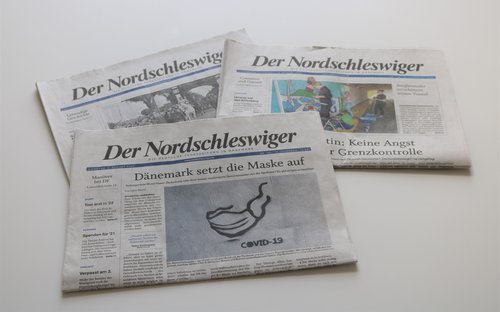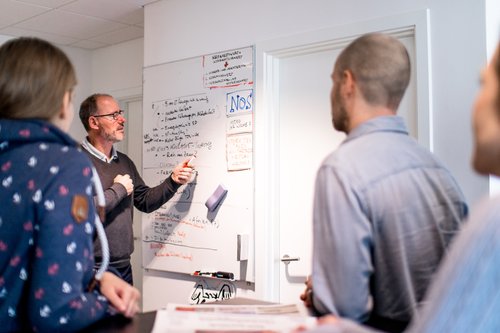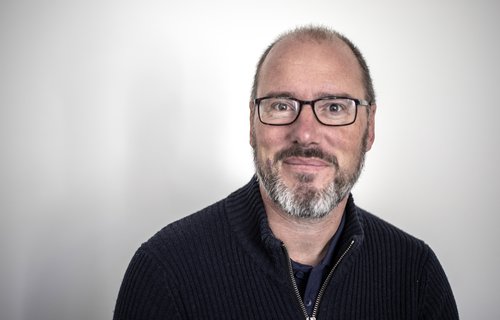Minority language media and the COVID-19 pandemic – the case of German in Denmark. An interview with Gwyn Nissen



A series edited and conceptualised by Dr. Sergiusz Bober and Craig Willis.
The German minority in Denmark is the focus of the sixth post in our ongoing expert interview series on minority language media and the effects of the COVID-19 pandemic. Chief Editor of Der Nordschleswiger, Gwyn Nissen, gives us an insightful overview of the situation for the German minority’s daily newspaper and its online news site, and the mixed effects the pandemic has had and is having. Readership figures have increased as the paper’s daily reporting, especially when delivered digitally, became more popular among the German minority, as well as found new readers within the wider Danish society and in Germany. In terms of topics, the difficulties arising from the controls introduced on the Danish-German border have been among the most intensely discussed. Interestingly, Der Nordschleswiger also kept readers informed about the challenges of working remotely during the height of the lockdown in Denmark, for example through the innovative concept of a quarantine blog.
Gwyn begins by outlining the background of the German minority in Denmark and the evolution of Der Nordschleswiger since its launch in 1946, before moving on to the COVID-19 pandemic effects.
As an introduction, could you please summarise the minority language media (MLM) situation in your linguistic sphere?
Denmark only has one officially recognised minority within the country: the German minority in North Schleswig, in the very south of Denmark on the border with Germany.
The sole minority media outlet of the German minority in Denmark is Der Nordschleswiger, a daily newspaper in existence since 1946, and its digital versions - nordschleswiger.dk (also available in app form). In the very near future Der Nordschleswiger will be primarily a digital news-site, as the daily newspaper will be published for the last time on 2 February 2021. At the same time, for non-digital readers Der Nordschleswiger will still have a printed service: a bi-weekly, “best of” production, composed of stories from our website. Both website and the bi-weekly newspaper will be free of charge for the readers.
Der Nordschleswiger is funded mainly by the German government through the main organisation of the German minority in Denmark, Bund Deutscher Nordschleswiger (approx. €2.4 million annually).
As a media outlet operating in Denmark, both the newspaper and its digital versions are also funded on the same level as any other majority-newspaper in the country. Der Nordschleswiger receives approx. €400,000 a year from the Danish Ministry of Culture. This funding will also carry on after the completion of the digitalisation process.
On top of that, over a four-year period (2018-2021) Der Nordschleswiger receives extra funding for the change from daily newspaper to a digital site. For the development of digital journalism and websites Der Nordschleswiger receives approx. €300,000 per year.
How has the COVID-19 pandemic affected the reporting of the MLM in your area and has there been any effect on readership / viewing figures?
The most important story for us in the last few months during the COVID-19 pandemic has been – apart from the pandemic itself and its effect on the society and also the minority – the closure of the Danish-German border.
We almost had daily reports on the problems it caused for people working in the neighbouring country, for families, friends, social life, business, and tourism.
Pressure from Der Nordschleswiger and other local media, as well as from the Danish and German minorities, local businesses and politicians, I believe, made the government soften some of the restrictions. Nevertheless, Denmark still has one of the most restrictive travel rules in Europe which severely affect the daily life in the Danish-German border region.
Therefore, this is an ongoing issue and it has given Der Nordschleswiger and the German minority massive public mention. On one side, Der Nordschleswiger has been of interest for other media and its staff members have been interviewed on live television in Denmark and Germany. Also, a new journalist Walter Turnowsky, who is the newspaper’s first correspondent permanently based in Copenhagen, was hired during the pandemic. He would present himself as “Der Nordschleswiger” during live press conferences with the Prime Minister of Denmark and other ministers – in prime-time television with millions of Danes watching. Thanks to this, the audience becomes more aware of the existence of the German minority in the south of the country, its newspaper, and COVID-19 repercussions in the Danish-German borderland.
On the other hand, we also experienced a massive growth in our online traffic. Whilst most of the people in the German minority also understand Danish and had no problem with following the prime minister Mette Frederiksen when she announced the lockdown, many of them still found their way to our website. This was the only place where they could find valid and in-time information about the Danish anti-COVID-19 measures.
We were also used as “information office”. For several months our staff and I personally were phoned and written to several times every day by minority members who needed information – even late in the evening and during weekends. In many situations we could help, and in others their questions led to new stories. The pandemic gave us a much closer relation with our readers who interacted much more actively than before.
This meant that during some days our traffic online was ten-fold that of a normal news day. We continue to have twice as large traffic when compared to the equivalent days in 2019. So, it seems some of the readers have stuck to us.
We also have rising audience numbers in other parts of Denmark. Therefore in total, the COVID-19 pandemic combined with our engagement in digital journalism throughout the last years has given us a rise in readership.
In term of economic aspects, the COVID-19 pandemic has of course had an effect on Der Nordschleswiger. Advertising revenues have suffered, however, this loss will partly be refunded by the state through a media funding package.
How has the lockdown / social distancing measures affected other covered content in MLM?
As with any other social group, the German minority and its organisations were also affected by the pandemic. Usually we write about our organisations and institutions on a daily basis, but with COVID-19 measures locking down most of the country there were less minority issues to write about. Everything was put to a halt, including the political process.
Of course, we have covered the special minority aspects of the situation: how schools, clubs, libraries, the elderly and other organisations cope with it and what the economic effects are. This was not any different from the majority population’s situation.
And although it felt as if we only wrote about the pandemic, this was also what the readers demanded. Because many measures and information changed very fast, there was a need for media summarising the ongoing situation.
Very often, when “big news” happens – terrorism, catastrophes etc. – we experience that the readers wander off to the large news sites. They do not believe that Der Nordschleswiger is the place to gather information and news in these situations. However, during the COVID-19 induced lockdown, it was the other way around – readers stuck to us and came to us, because in the Danish-German border region Der Nordschleswiger has a unique status and focus.
How has MLM covered issues of majority-minority relations and has the situation or voice of minorities been covered in majority media?
2020 was supposed to be a special year in the Danish-German border region. 100 years ago, the border was drawn between Denmark and Germany and the Danes in particular celebrated “Genforeningen” – the return of North Schleswig/Sønderjylland to Denmark. At the same time, the new border also gave birth to the minorities as we know them in Southern Denmark and Northern Germany. Thus, in timing with the 100th anniversary, over 1,000 events were planned over the whole country – but especially here in the border region. And then came the COVID-19 and the lockdown.
In a number of ways the cancellation of many Danish events left a lot of space and time for the media from Denmark, Germany but also from other European countries to focus on the German minority and its situation today. In 2020 every main newspaper and TV-station in Denmark had in-depth articles or programmes about the German minority. For example, Jyllands-Posten daily published a series of texts presenting an ethnically diverse town Tinglev/Tingleff, an individual and heartfelt story of belonging to a minority, and the evolution of Danish-German relations. It was probably one of the first occasions when Danish media came so close to the minority life and thinking, thus providing their audience with the opportunity to understand what it means and feels like to be part of a minority.
In what way has the pandemic affected MLM practitioners’ day to day work and have there been any future implications discussed?
Leading up to the pandemic we had already been preparing ourselves for the digital future. We have been working completely “web first” since the beginning of 2020 and we also had the communications infrastructure in place (using Slack software). Therefore, when the pandemic hit and forced all journalists to work from home, it only took us a very short time to adapt to the situation – and this mostly concerned only the internal communication and the workflow that had to be changed a little.
As editor-in-chief I was unfortunately one of the first to work from home because I was already quarantined a few days earlier, having arrived home from a skiing-trip in Austria (without being ill though). In my consequent quarantine-blog I informed readers how we were working from our homes as well as what content we were producing. It gave the readers insight into our reporting and their reactions were positive, especially on social media.
Some of the good habits we have stuck to: for example, daily video conferences with the colleagues who are not in the main office in Aabenraa/Apenrade and also many ordinary phone calls have been exchanged with more personal video calls.
Our employees are also more in their home office than before the pandemic.
How has social media in minority language played a role during the pandemic?
One of the aspects of a closer contact to our readers was of course the use of social media. For almost the last two years we have had our own social media employee to focus more on this field.
The COVID-19 pandemic has pushed this development forward. We get instant reactions to our articles and new questions that lead to new stories. Any development on the border situation sends thousands of readers from social media to our website.
Maybe surprisingly to some, the social media also opened our world (Der Nordschleswiger/the German minority) to the majority population. For instance, many Danes see our posts through Facebook and Instagram and also click to read them, although German might only be their second or third language. Whereas many Danes in earlier days would never have bought/read our daily newspaper.
Therefore, we have great expectations that the change from a daily newspaper to a digital news site will have a positive effect on the use and the presence of our media.
About the author:
Gwyn Nissen is the editor-in-chief at Der Nordschleswiger since July 2013 and before that was editor-in-chief and director of the transport-media organisation Dansk Transportforlag (2008-2013). Previously he spent 21 years at JydskeVestkysten (1987-2008), and had an initial stint at Der Nordschleswiger (1983-1987). Born in 1963 in Aabenraa/Apenrade, in the southern part of Denmark (North Schleswig/Nordschleswig/Sønderjylland), Gwyn now lives with his family in Rønshoved near the Danish-German border.


Commentaries
If you wish to write a commentary on this interview, please contact the editors Dr. Sergiusz Bober and Craig Willis.

